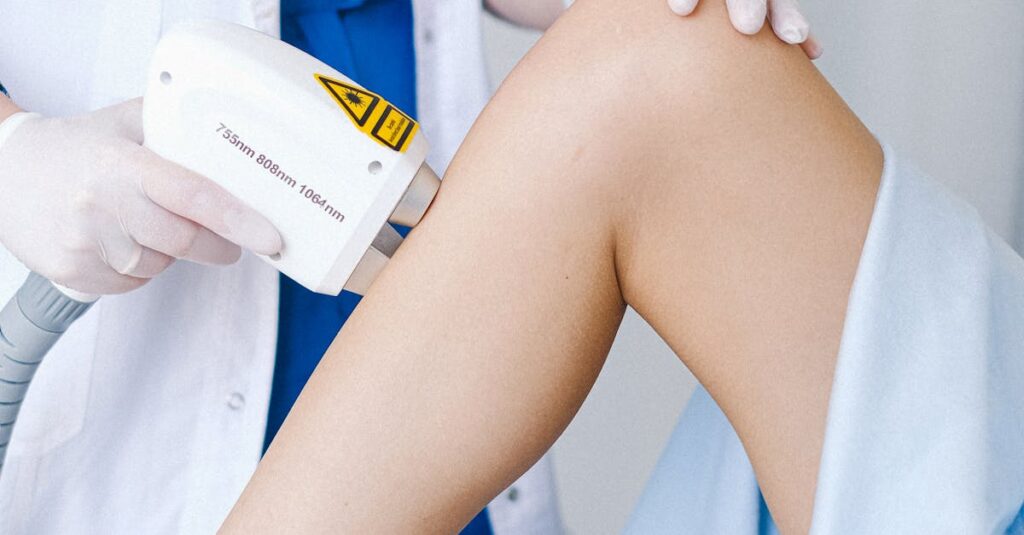Transcutaneous electrical nerve stimulation is a non-invasive technique of peripheral nerve stimulation.
It involves use of low voltage current that passes through the skin (to stimulates peripheral nerves) to relieve pain.
It consist of a sticky pads called electrodes that we attach on the skin where pain is situated.
It block the message or impulse going to the spinal cord or brain which helps in relieving pain sensation.
TENS is best known for relieving chronic pain.
How does TENS Unit work?
When TENS Unit is switched off, electrodes are placed near the pain source by the certified therapist.
On turning on the unit, it passes the electrical signal through the skin to stimulates peripheral nerve to relieve pain.
This works mainly on two theories :-
1). Electrical signal blocks the nerve cell that blocks the transmission of pain so that it cannot reach to your brain or spinal cord.
2). Electrical nerve stimulation increase the release of endorphins, which are the body’s natural pain killer chemicals.
Modes of TENS
1). Conventional TENS (high TENS) :-
- Most commonly used technique
- During Conventional TENS, low-intensity pulsed currents are administered at high
- frequencies
- Physiological intention – To stimulate large diameter non-noxious afferent (A beta) to
- produce segmental analgesia
- Strong painful paresthesia (prickling sensation) with minimal muscle activity
- Electrodes are placed at site of pain
- Analgesic profile – usually rapid onset and offset.
- Intensity – 12 – 30 mA
- Frequency – 10 -200 Hz
- Commonly used – 80 – 120 Hz
- Pulse width – 50 – 80 microsecond
- Duration – 20 -60 minutes
2). Acupuncture-like TENS (low TENS) :-
- Used less often.
- It last more than conventional TENS.
- Physiological intention – To stimulate cutaneous and motor afferents to produce extra segmental analgesia.
- Strong comfortable muscle twitching.
- Electrode placed at site of pain, motor nerve, acupuncture point, myotomes.
- May be delayed onset and offset.
- Intensity – 30mA
- Frequency – 2-5 Hz
- Pulse width – 150 – 300 Hz
- Duration – 30 -40 minutes
3). Brief intense TENS :-
- Physiological intention – To stimulate small diameter cutaneous afferents to produce counter irritation
- Painful sensation
- Electrodes are placed at site of pain, dermatomes, nerve trunk
- Rapid onset and delayed offset
- Intensity – as tolerated
- Frequency – 125 – 250 Hz
- Pulse width – 200 -250 microseconds
- Duration – 5 – 15 minutes
4).Burst TENS :-
- Physiological intention – To produce pain relief through stimulation of endogenous opiates
- Comfortable intermittent prickling sensation
- Electrodes are placed at site of pain, motor nerve, acupuncture points, dermatomes
- Long lasting
- Intensity – comfortable sensation
- Frequency – 50 -100 Hz, with burst
- Pulse width – 50 – 200 microseconds
- Duration – 20 – 30 minutes
For what we use TENS therapy
We uses this modality for the treatment of pain, some conditions for which we use this modality includes:-
- TENS for low back pain
- TENS for sciatica
- TENS for musculoskeletal pain
- TENS for postoperative pain
- TENS for chronic pelvic pain
- TENS for osteoarthritis
- TENS for fibromyalgia
- TENS for tendinitis
- TENS for diabetic neuropathy
- TENS for orofacial pain
How to use Transcutaneous electrical nerve stimulation (TENS) Unit?
TENS machines are small battery operated machines and can be used while we are working.
You can put it in your packet or hold it in your hand hence, a portal device.
First consult to your health professional or a certified therapist before using the TENS Unit.
Positioning the pads
Make sure that the machine is switched off then place the Electrode or pads on the either sides of painful area, at least 2.5cm (1 inch) apart.
Different sites where TENS electrodes can be applied :-
- Painful area
- Peripheral nerve
- Spinal nerve root
- Other specific points ( Acupuncture, trigger, or motor points)
- Dermatomes/myotomes
Turning the unit on and adjusting its strength
On turning on the TENS unit, you will feel a slight tingling sensation pass through your skin.
A dial on the machine will help you to control the strength of the electrical impulse.
Start with a low setting and gradually increase the setting until the sensation feels strong and comfortable.
If the sensation starts to feel painful then reduce it slightly.
After you switch off the machine, remove the electrodes from your skin.
Advantages of Transcutaneous electrical nerve stimulation (TENS)
- Non-invasive
- Portable
- User-friendly and safe to be used
- It is cheaper than regular prescription of analgesic
- Precaution and contradiction are few and side-effects are minimal
- Nonaddictive
Disadvantages of Transcutaneous electrical nerve stimulation (TENS)
- Some patients fails to tolerate this electrical sensation and fails to respond to this program.
- Skin irritation due to allergic reaction to the conductive medium or tape.
- A chemical burn may result.
Where it should not be used? (Contraindication)
- Patients with pacemaker (implantable device) -Do not use TENS over the area where an electronic device is implanted.
- Patients with allergy – Do not use it if the patient has an allergic reaction to medium or tape
- Epilepsy – Do not apply these electrodes to your head, neck or shoulder
- Treatment while driving – Do not use it while driving or operating machinery
- Deep vein thrombosis or thrombophlebitis – Do not use TENS unit as it may inncrease the blood circulation, which may increase the risk of dislodging a blood clot.
- Pregnancy – Do not use it in this situation
